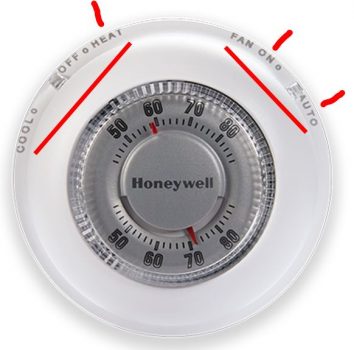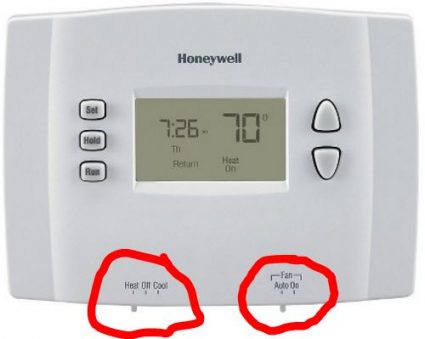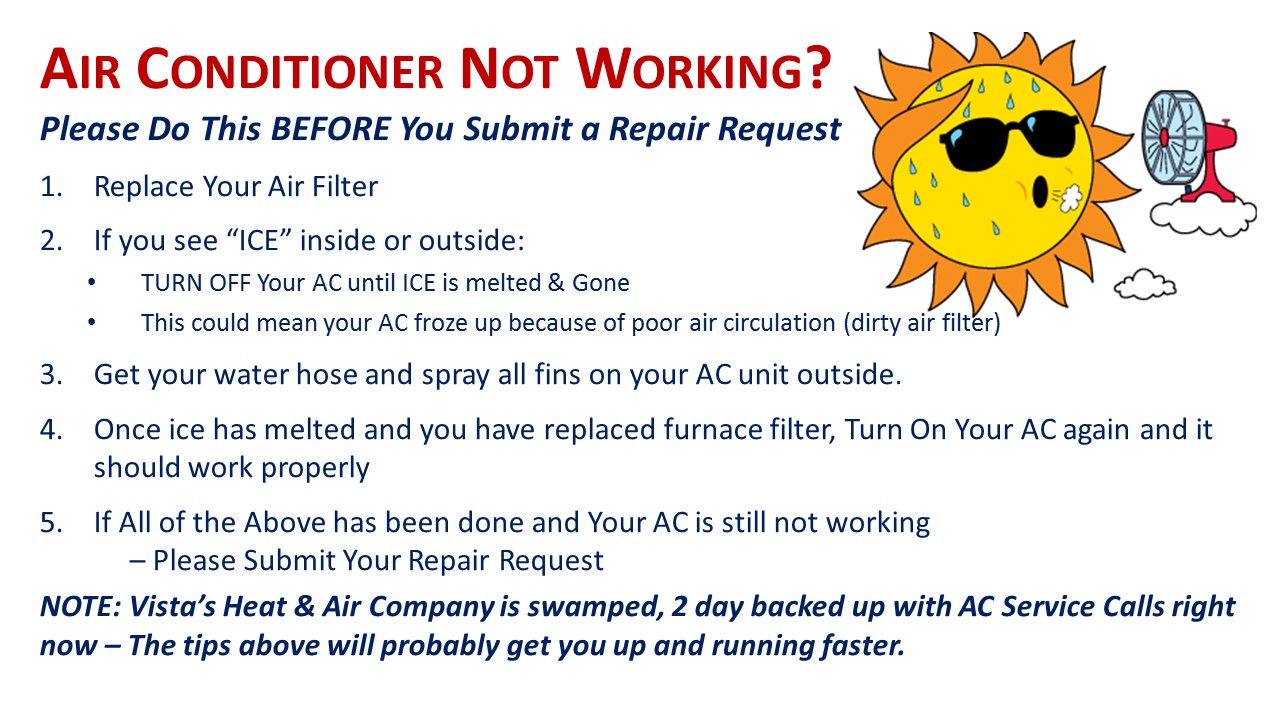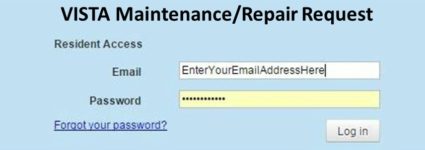
Please Try These Tips FIRST
BEFORE Your Maintenance Request
If These Tips Did Not Fix It,
Click Below – and PLEASE Submit Photos of Your Issue!
Emergency Winter Heating Tips

NO HEAT or BLOWING COLD AIR? check this first
- Check Your Air Filter – dirty air filter does not allow heat to get into your home – replacing monthly with new air filter allows your furnace to heat your home and reduces your heating bill
- Check ALL VENTS in Your Home – make sure nothing is blocking the vents – blocking these vents is the same as turning off your heat
- Check Your Thermostat (examples shown below)
- Make sure it is set to HEAT
- FAN SWITCH – make sure it is set to AUTO or ON
- if you have it set to AUTO, your fan will blow automatically when the furnace cycles on
- remember, even in the AUTO mode, your fan will continue to run after the furnace has cycled off. this helps to cool off your furnace- it may blow cold air during this ending cycle.
- If you set your fan to ON it will run 100% of the time, blowing both warm air and cold air. it never shuts off
- if you have it set to AUTO, your fan will blow automatically when the furnace cycles on


Still No Heat?
please click on issues below
Fall is here and now is the time to get your house in shape for the cooler months. Although autumn can be one of the busiest seasons for homeowners preparing for winter, it’s also the best time to take advantage of the moderate weather to repair any damages before the first frost sets in. Here are some home maintenance ideas that will keep your home running in peak condition all winter long.

Exterior maintenance
Check foundation for cracks and caulk around the areas where masonry meets siding, where pipes or wires enter the house, and around the windows and door frames to prevent heat from escaping. “Caulking and sealing openings is one of the least expensive maintenance jobs,” says Michael Hydeck, Hydeck Design Build, Inc., Telford, PA, and National President, National Association of the Remodeling Industry (NARI). “Openings in the structure can cause water to get in and freeze, resulting in cracks and mold build up,” he says. “Regardless of whether you live in a cold or warm climate, winter can bring very harsh conditions resulting in water or ice damage. A careful check of the outside structure combined with inexpensive maintenance can save you money in the long run.”
Install storm windows and doors and remove screens. Before storing, clean and repair screens, spray with a protective coating and place in a dry area of the basement or garage.
Inspect exterior walls to see if any paint is peeling or blistering on the house or outbuildings. According to Carl Minchew, Director, Benjamin Moore Paints, “Peeling paint is a sign that the existing paint film is failing and can no longer protect the siding of the building. Left uncorrected, the siding itself will deteriorate, leading to expensive repairs in the future.

Make sure the roof is in good shape. Inspect for missing and loose shingles. “Ice, rain, snow and wind combined with rapidly changing temperatures and humidity wreak havoc on roofs,” says Jay Butch, Director, Contractor programs for CertainTeed Roofing. “Your roof is your first defense in protecting your home. Without it functioning properly, water damage can occur. This causes deterioration to insulation, wood and drywall, making electrical, plumbing and HVAC systems vulnerable. It’s better to proactively deal with repairs in the fall than to discover a leaky roof during a snowstorm. For safety’s sake, have a licensed, certified roofing professional check the condition of your roof.”
After leaves have fallen, clean out the gutters and downspouts, flush them with water, inspect joints, and tighten brackets if necessary. Clogged gutters are one of the major causes of ice dams. Replace old or damaged gutters with new ones that have built-in leaf guards.
Examine your pool cover for damage and replace if necessary.
Weather-strip your garage door. Make sure the seal between your garage door and the ground is tight to prevent drafts and keep out small animals.
Inspect your driveway for cracks. Clean out and repair any damage with driveway filler, then coat with a commercial sealer.
Interior maintenance
“Heating and cooling amount to 47% of the energy costs in your home. Proper sealing and insulation can save up to 20% on heating and cooling costs, or up to 10% on your total annual energy bill,” says Katie Cody, spokeswoman for Lowe’s. “Air leaks from windows and doors are easy to find by moving your hand around the frame. Applying weather stripping and caulk to these areas will help cut down on drafts.”
Have your heating system checked by a licensed heating contractor. Heating systems will use fuel more efficiently, last longer and have fewer problems if properly serviced.

Get your woodstove and fireplace in working order. Gary Webster, Creative Director of Travis Industries, suggests that you examine your wood stove or fireplace insert’s door gasket for a tight seal. Also clean and inspect the glass door for cracks and have the chimney cleaned by a licensed chimney sweep. “A clogged chimney poses the risk of a chimney fire, which can be ignited by burning creosote—a combination of wood tar, organic vapors and moisture buildup,” says Webster.
Change the direction of your ceiling fan to create an upward draft that redistributes warm air from the ceiling.
Test and change the batteries in your smoke and carbon dioxide detectors and keep extra household batteries on hand.
Check basement windows for drafts, loose frames or cracked panes.
Vacuum internal parts of air conditioners. Remove units from windows or wrap outside box with an approved tarp or plastic air conditioner cover in order to prevent rusting of vital parts.
Clean your humidifiers regularly during the heating season. Bacteria and spores can develop in a dirty water tank resulting in unclean moisture misting out into your room.
Yard and garden maintenance
Organize your garage. Clean and store summer garden tools.
Clear leaves from lawn, reseed patchy areas, and plant spring flowering bulbs. If deer are a problem, start deer-proofing by covering plants with netting and chicken wire.
Prepare your yard equipment for storage. This includes draining fuel from all gas-operated equipment such as lawn mowers, leaf blowers, and chain saws.
Check to see that all of your snow equipment is up and running before the first flurry falls. Organize your snow clearing gear. When snow arrives you’ll want to have shovels, roof rakes and snow blowers where you can get to them. “Be careful where you store equipment,” says Travis Poore, The Lawn Ranger, a Home Depot Community Expert. “An outbuilding may not be as well insulated as a garage incorporated into a house. Equipment that is stored out in the elements, exposed to heat and cold extremes, can develop problems when the gasoline can no longer vaporize and flow into the combustion chamber of the engine.”
Drain garden hoses and store them inside. Also shut off outdoor water valves in cold weather. Any water left in exterior pipes and faucets can freeze and expand breaking the pipes.
Inspect and fill bird feeders. Keep in mind that once you start feeding birds you should continue on a regular basis throughout the winter months.
Fertilize the lawn with a high phosphorous mix to ensure healthy grass in the spring.

Porch and deck maintenance
Check the supports, stairs, and railings on porches and decks. Make sure the handrails can support someone slipping on snow or ice.
Clean porch and deck furniture, and look for any needed repairs. Cover and store outdoor furniture and barbecues in a protected area.
Make sure all soil is emptied from pots and planters. Dirt left in clay pots will freeze and cause the pots to crack if left outside.
Emergency Winter Heating Tips

NO HEAT or BLOWING COLD AIR? check this first
- Check Your Air Filter – dirty air filter does not allow heat to get into your home – replacing monthly with new air filter allows your furnace to heat your home and reduces your heating bill
- Check ALL VENTS in Your Home – make sure nothing is blocking the vents – blocking these vents is the same as turning off your heat
- Check Your Thermostat (examples shown below)
- Make sure it is set to HEAT
- FAN SWITCH – make sure it is set to AUTO or ON
- if you have it set to AUTO, your fan will blow automatically when the furnace cycles on
- remember, even in the AUTO mode, your fan will continue to run after the furnace has cycled off. this helps to cool off your furnace- it may blow cold air during this ending cycle.
- If you set your fan to ON it will run 100% of the time, blowing both warm air and cold air. it never shuts off
- if you have it set to AUTO, your fan will blow automatically when the furnace cycles on


Still No Heat?
please click on issues below
please click this link for additional EXTREME COLD WEATHER TIPS
Emergency Winter Heating Tips
(4 minute video)

NO HEAT or BLOWING COLD AIR?
Please Check these first BEFORE submitting a repair request
Check Your Air Filter
– dirty air filter does not allow heat to get into your home
– replacing monthly with new air filter allows your furnace to heat your home and reduces your heating bill
Check ALL VENTS in Your Home
– make sure nothing is blocking the vents
– blocking these vents is the same as turning off your heat
Check Your Thermostat (examples shown below)
– Make sure it is set to HEAT
FAN SWITCH – make sure it is set to “‘AUTO” or “ON”
-
-
-
- AUTO, your fan will blow automatically when the furnace cycles on
- remember, even in the AUTO mode, your fan will continue to run after the furnace has cycled off. this helps to cool off your furnace- it may blow cold air during this ending cycle.
- AUTO, your fan will blow automatically when the furnace cycles on
-
-
-
-
-
- ON it will run 100% of the time, blowing both warm air and cold air. it never shuts off
-
-


Still No Heat?
AIR CONDITIONING

Click PLAY BUTTON to WATCH THIS 2 minute video on your air conditioning

Louisville HEAT WAVE!
![]() NOTE: All Air Conditioners have a hard time when the temp is above 90 degrees and the humidity is super high.
NOTE: All Air Conditioners have a hard time when the temp is above 90 degrees and the humidity is super high.
When it’s 95 degrees or more outside…
your AC is doing a great job if it can get the inside temp down to 75 degrees
– an 18 degree reduction is good

Louisville Record High HEAT WAVE!
![]() NOTE: All Air Conditioners have a hard time when the temp is above 90 degrees and the humidity is super high.
NOTE: All Air Conditioners have a hard time when the temp is above 90 degrees and the humidity is super high.
When it’s 95 degrees or more outside…
your AC is doing a great job if it can get the inside temp down to 75 degrees
– an 18 degree reduction is good

Click PLAY BUTTON to WATCH THIS 2 minute video on your air conditioning

Summer is around the Corner!
AIR CONDITIONING
Louisville HEAT WAVE!
![]() NOTE: All Air Conditioners have a hard time when the temp is above 90 degrees and the humidity is super high.
NOTE: All Air Conditioners have a hard time when the temp is above 90 degrees and the humidity is super high.
When it’s 95 degrees or more outside…
your AC is doing a great job if it can get the inside temp down to 75 degrees
– an 18 degree reduction is good

XXXXXXXXXXXXXXXXXXXXXXXXXXXXXXXXXXXXXXXXXXXXXXXXXXXXXXXXXXXXXXXXXXXXXXXXXXXX



